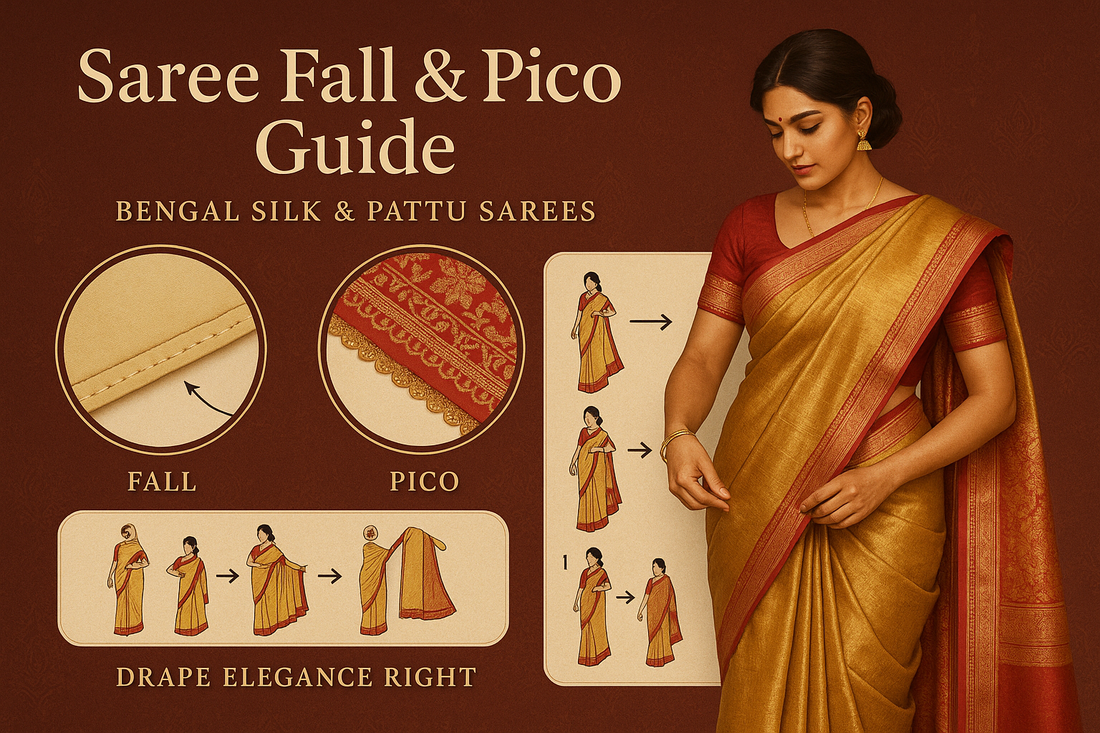
Saree Fall and Pico Guide for Bengal Silk & Pattu Sarees | Drape Elegance Right
Share
Demystifying bengal silk sarees Fall and Pico: What They Are & Why They're Essential
Bengal silk sarees Introduction:
The Secret to the Perfect Drape We imagine such sarees are elegance and tradition personified! But how, for example, does a saree flow so beautifully or fit the body so perfectly. The secret sometimes lies in two plain, yet mandatory finishing touches—the saree fall and pico.
Be it the royal Delia Bengal silk saree or an intricately designed Pattu, an opulent light purple georgette or a gem from your latest saree collection, the beauty and drape ability of your saree is enhanced with the correct fall and pico.
In this article, we will be breaking down the two most commonly asked questions about saree fall, and pico, find out why they are an absolute must for saree finishing, and give you expert tips on how to choose them and how to apply, care and reuse them too. We’ll also tell you where to find the best saree shop near you to get these services done right.
Chapter 1: What is Saree Fall and Pico?
-
So let’s begin by separating it out:
-
1.1 What is Saree Fall?
-
A saree fall is a long piece of fabric, usually 5 inches wide and about
-
2.5 meters long, stitched on to the inner lower hem (the part of the saree that comes into contact with your feet) of a saree.
-
Purpose of a Saree Fall:
-
There is some weight at the bottom and makes the saree draping more flattering.
-
Helps to resist fraying and ripping at the hem.
-
Gives a good shape and fall to the saree especially when saree is of thin material.
1.2 What is Pico (or Picot)?
Pico is an edged hem on fabric, designed either to protect the fabric from fraying or, as an ornament. The word comes from the French word “picot” in embroidery.
Purpose of Pico:
Locks in raw edges to stop fray so they don't fray.
Healthy and professional finish for the saree edges.
To Ready to wear, you needs to make the Saree ready.
These two events may seem like a small thing but it can do wonders to both how long you’ll be able to use your saree and how it would look after every use.
CHAPTER 2: FLAVOR We need to consider why Fall and Pico are indispensable.
Now that we know what irrglbt is, let’s investigate why they're important.
2.1 Improves Drape and Balance:
Without a saree fall, the material might appear lifeless and imperfect. The fall adds structure to the saree, ensuring it falls beautifully while framing the body.
2.2 Protects the Saree Fabric:
Sarees are prone to wear and tear through the bottom. A well-stitched fall also provides a cushioning layer, preventing friction and the resulting tears on the saree.
This is crucial for:
Expensive Bengal silk sarees
Intricately woven Pattu sarees
Lightweight georgette or chiffon sarees
2.3 Gives a Finished Look:
No saree, no matter how iconic, can look pretty if it doesn't have a pico. A nice tight pico stitch at the edges gives it a clean edge - you’ll want to show off those sarees at weddings to the office!
2.4 Requisite for Plats and Folds:
Falls also aid you create pleats and tucks of the saree in the proper manner. The saree might fly up or look bulky without the weight.
Chapter 3– Saree Fall & Pico In Different Fabrics
Different fabrics require different treatment. Let’s break it down:
3.1 Bengal Silk Sarees:
-
These silks are light weight have a soft texture and require a cotton fall to make them stiff.
-
Ideal Fall: Cotton (for breathability)
-
Pico Colour: Matching Saree base, or Contrast for style
3.2 Pattu Sarees (Kanchipuram):
-
These are the heavier kind of silk sarees and you will need a thick cotton, satin fall to support the zari borders and prevent sagging.
-
Perfect Fall: Thick cotton or satin
-
Pico (Both Saree and Dress): Gold or metallic, if zari borders are similar to body color.
3.3 Light Purples in Georgette and Chiffonsical:
-
Pastel hues in sarees and they are trendy, delicate and have tendency to fray. You need a soft, lightweight fall here.
-
Perfect Fall: Tissue or lightweight cotton
-
Pico Thread: Clear Or Tone-to-Tone Pastel
3.4 Plain Sarees vs Designer Sarees:
-
Fit For Daily Wear: wear resistant pico & sturdy fall for long lasting of the saree.
-
Designer Wear: Choose invisible or designer pico with fancy falls.
Chapter 4: The Mechanics of Fall and Pico
Have you ever wondered what really happens behind the scenes? Here’s how the experts do it:
4.1 Pico Stitching:
Edge is folded about 1/4 inch toward inside.
The fold is secured with a zigzag machine stitch.
Matching thread, or a contrasting color is selected based on the look desired.
4.2 Fall Stitching:
The drop is centered 2 inches below the top edge.
Stitched from the inside of the Saree so no threads on the front.
Fall should never be visible on the outside.
It is along the bottom pleats and the pallu part.
Pro Tip: Don’t stick the fall with Elmer’s or adhesive strips, it wrecks the fabric over time.
Chapter 5: DIY or Professional Help?
5.1 Can You Do It at Home? If you own a sewing machine and have a steady hand, you can stitch pico and fall yourself. But it requires precision.
5.2 Why Tailors Are Better They ensure even fall placement. Use proper machine settings. Match threads and fabrics perfectly. You save time and avoid errors. Use a saree shop near you or tailoring services from trusted boutiques that specialize in ethnic wear.
Chapter 6: Saree Collection Without Fall & Pico?
No Way! Imagine investing in a premium saree collection only to find they’re not wearable because they lack proper finishing. Whether you’re a saree retailer or a fashion-conscious buyer, fall and pico must be part of your collection checklist. What to Look for in a Well-Finished Saree:
✅ Neat pico stitch on all edges
✅ Invisible fall from outside
✅ Fall matches saree tone or is contrast with purpose
✅ Even pleats and no puckering at the hem Before buying that dreamy light purple saree, ask: "Is fall and pico done?"
Chapter 7: Common Mistakes to Avoid
❌ Fall stitched on the outer side This is a rookie mistake and looks very unpolished.
❌ Wrong color fall Using a fall that bleeds color or mismatches ruins the look.
❌ No pico on delicate fabrics Even high-end designer sarees start fraying without pico. Always insist on it!
Chapter 8: Where to Get Saree Fall and Pico Done?
9.1 Near Saree Shop or Tailor Most local tailoring shops around saree markets or malls provide same-day fall and pico services. Just search for: 🧵 “Saree fall and pico service near me” 🧵 “Blouse stitching & saree finishing near [your area]”
9.2 Online Saree Shops Many modern saree websites now provide: Fall and pico add-on options Sarees delivered with finishing Custom color choices for fall Popular stores also offer doorstep tailoring services.
Chapter9: Tips to Maintain Saree Fall & Pico Do not wash frequently –
Dry clean delicate sarees. Inspect fall stitching after 5–6 wears—reinforce if needed. Store rolled or folded neatly—don’t crush the hemline. Especially for heirloom sarees like Bengal silk or Pattu, maintenance of fall and pico ensures they last for generations.
Chapter 10: Trends in Fall and Pico – A Designer’s Twist Yes
even fall and pico are seeing stylish upgrades: Contrast Color Falls – To highlight pleats. Lace or Beaded Pico – For festive designer sarees. Decorative Hem Tapes – Seen in bridal couture. Ready-to-Wear Sarees with Pre-Stitched Falls Fashion-forward saree lovers are now using fall and pico not just as function—but as fashion.
Conclusion Achieving Elegance together
The autumn and the pictures of a saree might seem like a flimsy addition however they are the main components of a flawless wrap. You can choose to wear an old-fashioned Bengal silk saree beautiful wedding Pattu or a delicate gentle purple georgette. The things that make this experience special is the fall and pico. The finishing touches are these two to your saree collection. If you have just purchased the latest saree, you should take your saree to a store or a reputable tailor to have it sewed and pinned just perfect. Since every gorgeous saree style is a perfect fall, and a stunning pico to hold it all together.
Quick Recap: Checklist Before Wearing a Saree
Stitching on the inside of the fall
Pico well applied to every edge
Fabric and color of the fall complement or even enhance the your saree
Pleated pleats that are tailored hold up well due to autumn
The edges of sarees don't get frayed over time.
FAQs About Saree Fall and Pico
Q1. What can I wear under a saree without picture or fall?
Technically, it's real. But, it's not likely to appear attractive or last for many years.
-
What is the length of time that it will take to get the autumn season to be over and Pico is to be completed?
The typical time is 1 to 2 days, based on the specific.
Q3. Does every outfit require fall or pico?
Absolutely, particularly silk, chiffon georgette along with other types of materials which are fragile.
Q4. Is it possible to request that the fall and pico removed or changed?
A skilled tailor will make repairs or replacements according to the need.
-
Do you notice a difference in the picture of silk and cotton?
The cotton receives stitches that are stronger, and silk is able to develop thicker, softer edges.
